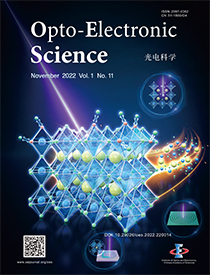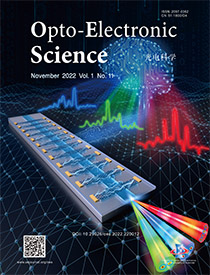2022 Vol. 1, No. 11
Cover story: Tan DZ, Sun K, Li ZL, Xu BB, Qiu JR. Photo-processing of perovskites: current research status and challenges. Opto-Electron Sci 1, 220014 (2022).
As human civilization goes through the information revolution, everything seems to be speeding up, and the desire of researchers to explore next-generation semiconductor materials with excellent optoelectronic properties has significantly increased. The past decades have witnessed a growing interest in metal-halide perovskites due to their impressive optoelectronic properties, such as large absorption coefficient, tunable band gap, long carrier diffusion length, low exciton binding energy, high defect tolerance, and so on. Metal-halide perovskites have been endowed with great potential in diverse photovoltaic and optoelectronic devices and applications. In the process of moving from materials to applications, patterning is often a key part. Due to the low formation energy and ionic crystal structure of metal-halide perovskite, photo-processing can be applied as a high-throughput, simple, and chemically clean method of synthesizing, modifying structures, and patterning. Furthermore, the high mobility of ions (halide ions) offers a unique possibility for the photo-processing of perovskites, which can induce various effects, such as photo-processing of perovskites for synthesis, patterning, ion exchange, phase transition, assembly, and ion migration and redistribution. Further exploration for the phenomena and mechanisms of photo-processing will facilitate the modulation of the optoelectronic properties of perovskite materials.
Back cover story: Zheng ZH, Zhu SK, Chen Y, Chen HY, Chen JH. Towards integrated mode-division demultiplexing spectrometer by deep learning. Opto-Electron Sci 1, 220012 (2022).
Miniaturized spectrometers have been widely researched in recent years, but few studies are conducted with on-chip multimode schemes for mode-division multiplexing (MDM) systems. Due to strong coupling effects between guide modes, it is challenging to achieve both mode demultiplexing and spectral detection in a single device. Therefore, the on-chip multimode spectrometers compatible with MDM systems still remain as an open problem.
Recently, the authors of this article propose the concept of MDM spectroscopy, and design the first on-chip mode-division demultiplexing spectrometer. This spectrometer mainly consists of a branched multimode waveguide and an array of photodetectors, achieving the integration of mode demultiplexing and spectral detection. Imposing deep neural networks to solve inter-mode nonlinear coupling problem, the researchers realize the functions of single-shot reconstruction for multimode spectra and multi-shot spectral resolution enhancement. Under the measurement of 25 photodetectors in the bandwidth of 1500-1600 nm, the 15-nm resolution of parallel reconstruction for TE1-TE4 is achieved by a single shot. Besides, the 3-nm resolution is realized by stacking the multimode responses in TE1-TE4 to the single spectrum. This work facilitates the marriage of optical mode identification and spectral recognition in a single device, which may find important applications, such as optical communications and sensing, in the MDM systems.

-
{{article.year}}, {{article.volume}}({{article.issue}}): {{article.fpage | processPage:article.lpage:6}}. doi: {{article.doi}}{{article.articleStateNameEn}}, Published online {{article.preferredDate | date:'dd MMMM yyyy'}}, doi: {{article.doi}}{{article.articleStateNameEn}}, Accepted Date {{article.acceptedDate | date:'dd MMMM yyyy'}}CSTR: {{article.cstr}}
-
{{article.year}}, {{article.volume}}({{article.issue}}): {{article.fpage | processPage:article.lpage:6}}. doi: {{article.doi}}{{article.articleStateNameEn}}, Published online {{article.preferredDate | date:'dd MMMM yyyy'}}, doi: {{article.doi}}{{article.articleStateNameEn}}, Accepted Date {{article.acceptedDate | date:'dd MMMM yyyy'}}CSTR: {{article.cstr}}

 E-mail Alert
E-mail Alert RSS
RSS



